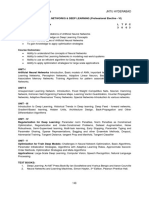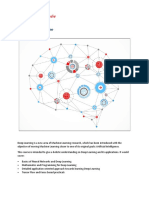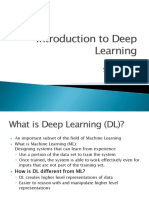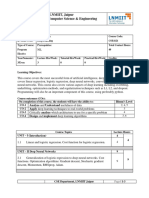0 ratings0% found this document useful (0 votes) 91 views2 pagesNeural Networks and Deep Learning
Neural networking and deep learning
Copyright
© © All Rights Reserved
We take content rights seriously. If you suspect this is your content,
claim it here.
Available Formats
Download as PDF or read online on Scribd
R18 B.Tech. CSE (AIML) III & IV Year INTU Hyderabad
NEURAL NETWORKS AND DEEP LEARNING
B.Tech. IV Year| Sem.
or
od
ov
wo
Course Objectives:
‘© Tointroduce the foundations of Artificial Neural Networks
* To acquire the knowledge on Deep Learning Concepts
‘© Toleamn various types of Artificial Neural Networks.
+ To gain knowledge to apply optimization strategies
Course Outcomes:
‘© Ability to understand the concepts of Neural Networks
‘+ Ability to select the Learning Networks in modeling real world systems
‘+ Ability to use an efficient algorithm for Deep Models
‘© Ability to apply optimization strategies for large scale applications
UNIT-1
Artificial Neural Networks Introduction, Basic models of ANN, important terminologies, Supervised
Learning Networks, Perceptron Networks, Adaptive Linear Neuron, Back-propagation Network.
Associative Memory Networks. Training Algorithms for pattern association, BAM and Hopfield
Networks.
UNITAI
Unsupervised Leaming Network- Introduction, Fixed Weight Competitive Nets, Maxnet, Hamming
Network, Kohonen Self-Organizing Feature Maps, Leaming Vector Quantization, Counter Propagation
Networks, Adaptive Resonance Theory Networks. Special Networks-Introduction to various networks.
UNIT «IIL
Introduction to Deep Learning, Historical Trends in Deep leaming, Deep Feed - forward networks,
Gradient-Based learning, Hidden Units, Architecture Design, Back-Propagation and Other
Differentiation Algorithms
UNIT -IV
Regularization for Deep Learning: Parameter norm Penalties, Norm Penalties as Constrained
Optimization, Regularization and Under-Constrained Problems, Dataset Augmentation, Noise
Robustness, Semi-Supervised learning, Multi-task learning, Early Stopping, Parameter Typing and
Parameter Sharing, Sparse Representations, Bagging and other Ensemble Methods, Dropout,
Adversarial Training, Tangent Distance, tangent Prop and Manifold, Tangent Classifier
UNIT-V
Optimization for Train Deep Models: Challenges in Neural Network Optimization, Basic Algorithms,
Parameter Initialization Strategies, Algorithms with Adaptive Learning Rates, Approximate Second-
(Order Methods, Optimization Strategies and Meta-Algorithms
Applications: Large-Scale Deep Learning, Computer Vision, Speech Recognition, Natural Language
Processing
TEXT BOOKS:
1. Deep Learning: An MIT Press Book By lan Goodfellow and Yoshua Bengio and Aaron Courville
2. Neural Networks and Learning Machines, Simon Haykin, 3" Ecition, Pearson Prentice Hall�R18 B.Tech. CSE (AIML) III & IV Year INTU Hyderabad
DEEP LEARNING LAB
B.Tech. IV Year| Sem.
or
od
wv
20
Course Objectives:
1. To Build the Foundation of Deep Learning,
2. To Understand How to Build the Neural Network.
3. To enable students to develop successful machine leaming concepts.
Course Outcomes:
1. Upon the Successful Completion of the Course, the Students would be able to:
2. Learn the Fundamental Principles of Deep Learning,
3. Identity the Deep Learning Algorithms for Various Types of Learning Tasks in various domains
4, Implement Deep Leaming Algorithms and Solve Real-world problems.
LIST OF EXPERIMENTS:
1. Setting up the Spyder IDE Environment and Executing a Python Program
Installing Keras, Tensorflow and Pytorch libraries and making use of them
Applying the Convolution Neural Network on computer vision problems
Image classification on MNIST dataset (CNN model with Fully connected layer)
Applying the Deep Leaming Models in the field of Natural Language Processing
Train a sentiment analysis model on IMDB dataset, use RNN layers with LSTM/GRU notes
Applying the Autoencoder algorithms for encoding the reel-world data
Applying Generative Adversial Networks for image generation and unsupervised tasks.
TEXT BOOKS:
1. Deep Learning by lan Goodfellow, Yoshua Bengio and Aaron Courville, MIT Press.
2. The Elements of Statistical Learning by T. Hastie, R. Tibshirani, and J. Friedman, Springer.
3. Probabilistic Graphical Models, Koller, and N. Friedman, MIT Press.
REFERENCES:
1. Bishop, C.M., Pattern Recognition and Machine Learning, Springer, 2006,
2. Yegnanerayana, B., Artificial Neural Networks PHI Learning Pvt. Ltd, 2009
3. Golub, GH., and Van Loan, C-F., Matrix Computations, JHU Press, 2013.
4, Satish Kumar, Neural Networks: A Classroom Approach, Tata MeGraw Hill Education, 2004,
EXTENSIVE READING:
1. httpu/www.deeplearning.net
https:/www.deeplearningbook.org/
https:1/developers. google.com/machine-learning/erash-course/m|-intro
www.cs.toronto.edu/~fritz/abspsfimagenet. pdf
http://neuralnetworksanddeeplearning.com/
























































